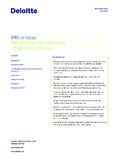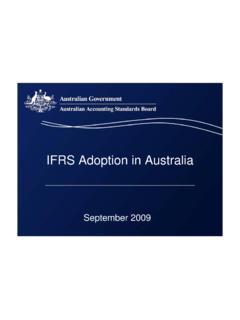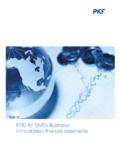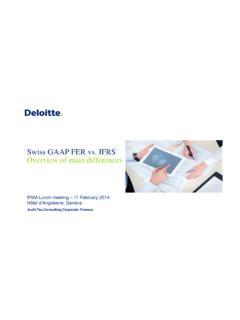Transcription of IFRS 9 Financial Instruments - EY
1 ifrs 9. Financial Instruments ifrs 9 Financial Instruments 1. Overview On 24 July 2014, the Our experience, in combination with EY tools and International Accounting accelerators, provides a tailor-made solution for Financial Standards Board (IASB) issued institutions globally. We have proven professional the final version of ifrs 9 experience on the three topics of ifrs 9, namely Financial Instruments , bringing together the classification and measurement, impairment and hedge accounting topics 1) Classification and measurement, of the IASB's project to replace 2) Impairment, and IAS 39 Financial Instruments : Recognition and Measurement and all previous versions of ifrs 9. 3) Hedge accounting The mandatory adoption date in January 2018. has forced Financial institutions to plan for the implementation of ifrs 9. It will require three years of preparation, assuming two years to implement and one year of parallel run, to ensure readiness for 2018. Our experiences working with entities that are assessing the impact of ifrs 9 suggests that it will take significant time to implement the changes in a robust and strategic manner, given the impact on data, systems, models, regulatory capital and KPIs.
2 2 EY. Key messages for bank executives CFOs and finance CROs and risk function Need to manage early expectations of investors or The new impairment rule of calculating expected other stakeholders and communicate the potential loss will require evaluating available qualitative impact of the changes; data, data processes used by risk and reconciliation with finance. This is the most significant of all the The accounting changes beyond those specific to expected changes;. ifrs 9 are not insignificant several require more disclosures and changes to the Financial statement The new implementation will require tracking presentation; and determining significant changes in credit risk throughout the lifetime of Financial assets;. Need to consider the capital and regulatory impact;. The proposed changes to hedge accounting may Need to assess the impact on downstream systems allow additional hedging opportunities but will also such as client profitability and relationship manager cause changes to existing processes.
3 Levels;. The revised approach to classification and CFO may take this opportunity to further align risk measurement of Financial Instruments may result and finance data. in a change in Instruments used by treasury. It may also impact products sold or traded by front office which will require a change in risk management COOs and operational function considerations;. The upcoming accounting changes will impact Regional organizations that are moving towards several processes and systems, the impairment centralization of their finance and risk data process system. The interaction between fair value information may consider centralizing credit risk hedge accounting and impairment will be more modelling in a center of excellence. complex under the new impairment model of ifrs 9. Alignment of key controls within the new processes will be required with the adoption of the ifrs 9. standard;. There will be changes in IT systems due to the Banks are encouraged to establish implementation of ifrs 9; Steering Committees including Amendment to the existing client sectors/portfolio representatives from functions of to the impairment credit risk model will require Risk, Finance, Operations, IT, etc.
4 Additional data attributes and appropriate corporate governance structures to be put in place in the for setting up the overall program related systems and processes. governance and roadmap, as well as internal monitoring of the implementation progress. ifrs 9 Financial Instruments 3. ifrs 9 Accounting summary 2018 adoption date for ifrs 9 3 topics to adopt A mandatory effective date consistent with stakeholder requests (a 3-year lead time). Topic 1: Classification and measurement Revised approach to measurement of all Financial assets and liabilities Principle-based, unified model based on both the use of assets within an entity's business model and the nature of the cash flows Financial assets are reclassified between measurement categories only when the business model for managing them changes Debt (including hybrid contracts) Derivatives Equity Fail Yes Characteristics test (at instrument level) Held for trading? Pass Business model test (at an aggregated level).
5 No 1 Hold to collect 2 Both (a) to 3 Neither (1). contractual hold to collect nor (2). cash flows contractual cash flows; and (b) to sell Yes No Conditional FVO elected? FVOCI option elected? No No Yes Amortized FVOCI FVOCI. New FVTPL. cost (with recycling) (no recycling). 4 EY. Topic 2: Impairment Fundamental redesign of provisioning model for Financial assets, Financial guarantees, loan commitments and lease receivables Move from an incurred loss' model to an expected loss' model Earlier recognition of impairment 12-month expected losses for performing assets and lifetime expected losses for non-performing assets to be captured upfront Initial recognition Credit-impaired on (with exceptions) initial recognition Allowance: 12-month expected Lifetime expected credit losses credit losses Criterion: The credit risk has increased significantly since initial recognition +. Objective evidence of impairment Interest revenue Gross carrying amount Gross carrying amount Net carrying amount based on: Change in credit quality since initial recognition improvement deterioration ifrs 9 Financial Instruments 5.
6 Topic 3: Hedge accounting New standard aimed at simplifying existing hedge accounting rules Reflects more accurately how an entity manages its risk and the extent to which hedging mitigates those risks Removes some of the operational burden associated with hedge effectiveness testing More risks can be hedged Leaves room to choose an accounting policy of either applying the hedge accounting requirements of HKFRS 9 or continuing to apply the existing hedge accounting requirements in HKAS 39 for all hedge accounting because the project on accounting for macro hedging has not yet been completed Positive changes No change or neutral impact Disadvantages Hedging risk components Hedge documentation required Unclear how guidance on macro at inception or dynamic cash-flow hedging is Less volatility in P/L due to the carried forward in ifrs 9. exclusion of time value of options, 3 types of hedge relationships forward points and currency basis remain the same Voluntarily de-designation prohibited if risk management Aggregated exposures (including Cash Flow Hedge objective remains the same derivative) as hedged item Fair Value Hedge Net Investment Hedge Disclosure ( ifrs 7) is more Elimination of the 80-125% onerous quantitative threshold for Ineffectiveness is still measured recognizing effectiveness and booked No retrospective effectiveness testing Emphasis on qualitative factors for prospective effectiveness assessment Hedging using credit derivatives Expanded ability to hedge net positions / hedge layers of hedged items in fair value hedges Rebalancing instead of discontinuation and redesignation (volume only).
7 6 EY. ifrs 9: Activity timeline 2015 2016 2017 2018. Impact assessment phase Build, test & deploy Go-live Program governance Operating model Board level project sponsorship and engagement Document and agree detailed design of ideal operating model and highlight changes required Strong senior management ownership of the project setting clear objectives and deadlines Ensure consistency with the overall bank operating model and interaction of different subsidiaries Finance leader on Steering Committee typically provides Perform a detailed assessment of cost and overall coordination, with impairment led by Risk delivery risk Requires close coordination among Risk, Finance, Banks may consider changing operating models, Business centralized vs decentralized data and Regional vs local program governance structure processing Financial impact assessment Model build Determine impact assessment methodology Perform a comprehensive review of design and material portfolios for modelling options where existing model coverage is Customized modelling approach for material misaligned or incomplete portfolios, with extrapolation for smaller Design new models.
8 Significant focus on Point- portfolios in-Time PDs and LGDs and term structures Parallel / Proving run Determine key assumptions for each portfolio Consider internal and external data required and sensitivities / stresses to be used for forward-looking adjustments /overlays Key activity Provide insights into drivers of Financial and Perform model validation capital impact Go live Gap analysis and impact on Data / systems and controls downstream systems Drive changes to data architecture, focus on Assessment of existing practices: models, known data quality gaps methodologies and operating models Update key controls within the model process, Review of data availability and quality data aggregation process and key finance v risk reconciliations Benchmarking to market / peer practices and how they are evolving Document revised end-to-end processes and ownership matrix Impact on internal management information, key performance indicators, etc Data architecture - catalyst to centralize data in a single golden source.
9 Implementation roadmap Reporting & disclosure Prepare multi-year implementation roadmap Analyze and conclude on key accounting for senior stakeholders judgments Highlight key activities and milestones, Design processes to produce required data stakeholder engagement, market and regulator for risk reporting, Internal MI and Financial communications statements Maintain flexibility for possible early adoption. Determine impact on capital and budgeting /. Highlight key dependencies planning Period of dual reporting during the parallel run Discuss with external stakeholders and regulators stage Chart of account changes Stakeholder management Training ifrs 9 Financial Instruments 7. EY insight EY advisory's support of a number of banks in Hong Impairment Kong, UK and Australia during the impact assessment has given us a better understanding of the practical Replacement of the IAS 39 incurred loss impairment issues in applying the new requirements. EY has skilled model by the ifrs 9 expected loss model is expected and knowledgeable resources and proven systems, to reduce equity and have an impact on regulatory methodologies and track record.
10 Some of the key capital. The level of allowances will also be more considerations are highlighted below: volatile in the future, reflecting changes in forecasts. Apart from building new credit models or enhancing the existing credit models, data quality is also critical Classification and measurement to successfully adopt ifrs 9, considering that the The new approach of classification and measurement new approach requires the banks to factor in future including the new Fair Value through Other expected credit losses into their loan loss provision. Comprehensive Income ( FVTOCI ) category, provides Management is encouraged to assess this at an early opportunities for banks to reassess the measurement stage with consideration of the regulatory ( Basel). basis of the existing loan portfolios and designate the and business constraints. portfolio to reflect and achieve an outcome consistent with the bank's objectives ( to minimize volatility to profit or loss, optimize the funding requirements and Hedge accounting regulatory capital, etc.)
















